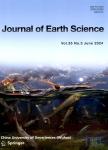Ore geology, H–O–C isotopes andAr–Ar dating of the Wutonggou iron deposit, eastern Tianshan, NW China: Implications for the source, timing, and genesis of hydrothermal mineralization in a sedimentary iron deposit
Ore geology, H–O–C isotopes andAr–Ar dating of the Wutonggou iron deposit, eastern Tianshan, NW China: Implications for the source, timing, and genesis of hydrothermal mineralization in a sedimentary iron deposit作者机构:State Key Laboratory of Geological Processes and Mineral Resources, Collaborative Innovation Center for Exploration of Strategic Mineral Resources, School of Earth Resources, China University of GeosciencesWuhan MNR Key Laboratory of Metallogeny and Mineral Assessment, Institute of Mineral Resources, Chinese Academy of Geological Sciences
出 版 物:《Journal of Earth Science》 (地球科学学刊(英文版))
年 卷 期:2022年
核心收录:
学科分类:081803[工学-地质工程] 08[工学] 0818[工学-地质资源与地质工程]
基 金:supported by the National Key R&D Program of China Ministry of Science and Technology (2018YFC0604005) the China Geological Survey through Geological Survey Project Grant (No. 1212011085527)
摘 要:The Wutonggou iron deposit is located in the well-known iron metallogenic belt in the eastern Tianshan, NW China, and has been regarded as a sedimentary iron deposit. Hydrothermal overprinting could play indispensable roles in the formation of high-grade iron ores in sedimentary iron deposits, thus the nature and evolution of hydrothermal fluids have important implications on the genesis of these deposits. Consequently, an integrated study of ore geology, H–O–C isotopes andAr–Ar dating, is conducted on the Wutonggou deposit, in order to reveal the features, source, and timing of hydrothermal mineralization. The studied deposit includes two mining sections namely the Jianshan and Wutonggou. The δO values of early magnetite from the Jianshan section range from +3.0‰ to +5.8‰ that nearly consistent with classic magmatic magnetite, while increases to 6.3‰–8.0‰ in the late stage. Quartz from the two sections shows comparable H–O isotopic compositions and identical fractionation trends, and is plotted in or periphery to the primary magmatic water area. Calcites from the two sections are broadly similar in carbon and oxygen isotopic compositions, and siderite from the Wutonggou section is plotted in the same region. Thus, comparable stable isotopic compositions and evolution trends indicate similar magmatic fluids contributed hydrothermal iron mineralization in the two mining sections. Moreover, water-rock interactions of varying degrees generated distinct mineralization styles in the Jianshan and Wutonggou sections, and caused the isotopic fractionation in late stages. Biotite extracted from a hydrothermal siderite ore yielded aAr–Ar plateau age of 299.5 ± 2.0 Ma, indicating the timing of hydrothermal iron mineralization is corresponding to the emplacement of vicinity granitoids. Taken together, the hydrothermal mineralization in the Wutonggou iron deposit was the product of remobilization and upgrading of early sedimentary iron ores, and ore-forming fluids were most probably originated from regional granitic magmatism.



